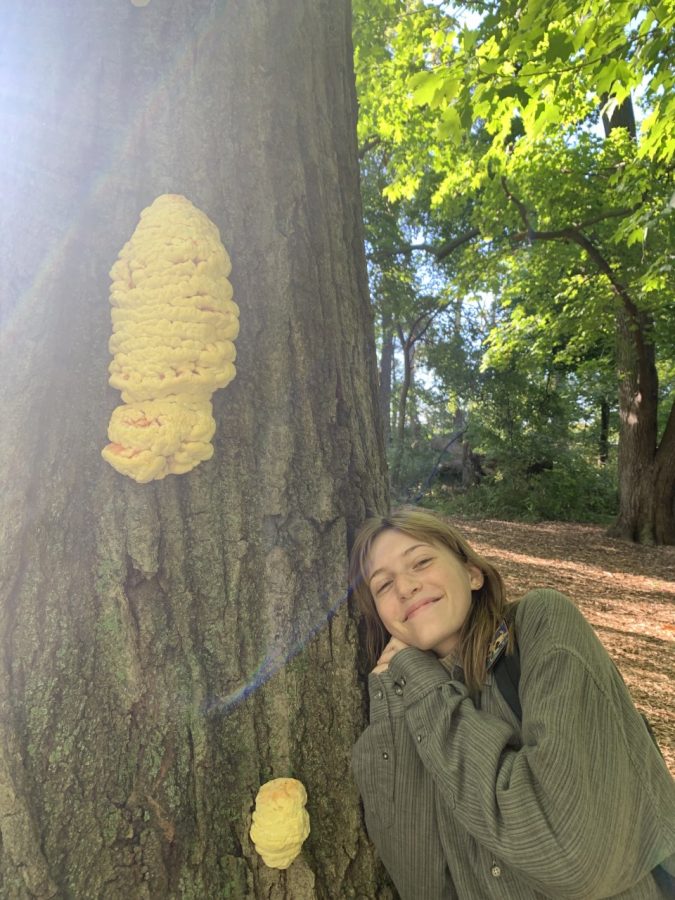This story is part of a series called “Foraging for the Future.” Jenna Koch will be sharing her foraging experiences while also providing insight into how we can mitigate climate change and connect with the environments around us in this series.
I was one of the few unlucky Cobeen Hall residents who had to quarantine last year due to a COVID-19 outbreak Sept. 25, 2020. After deciding to go home for that two-week period, it seemed like it was going to be a boring two weeks of online school, but it ended up being one of the most transformative experiences of my life.
My family took the opportunity to go hiking and stumbled upon a magnificent creature in our local woods: “Laetiporus sulphureu,” commonly known as Chicken of the Woods. It was the first mushroom I ever foraged, and its bright yellow underside and chicken-like flavor was unforgettable.
Nearly a year later, I found myself at the Riverside Urban Ecological Center, standing beside the same mushroom that ignited my interest so long ago. As soon as I walked onto the path, a bright sulfur yellow and earthy scent greeted me immediately. COTW breaks down all common perceptions of mushroom hunting — it’s not hard to identify and there are hardly any poisonous look alikes.
However, as with all foraging, one must practice caution. “Lapetiporus huroniensis” is nearly identical to “Laetiporus sulphureu,” but it grows on conifers instead of deciduous trees. “Lapetiporus huroniensis” is known to cause cases of gastrointestinal upset due to toxins in conifers. Always consult multiple sources or contact a professional before consuming a wild mushroom.
Mushroom hunting can feel intimidating at first, which is why COTW is a good beginner mushroom. Identification can be tricky and as names often change with new research. Additionally, many feel afraid of mushrooms.
According to a Maine-based mushroom company called North Spore, the U.S. is currently a mycophobic society, meaning the majority of people are afraid or at least disinterested in mushrooms. I’m often met with surprise from even my nature-loving family members. They ask how I could possibly know which are poisonous and which are edible, or tell me I’m damaging nature by foraging every once in a while.
However, when I talk to other young people, I’m often met with a different response. I recently went on a field trip to the Riverside UEC for an English class, and nearly everyone I spoke with was interested in finding mushrooms on the trip. Mycophobia seems to be less common in younger generations.
This mindset will help move us toward a more open and environmentally conscious society.
For example, psilocybin-containing mushrooms are getting the recognition they deserve as effective mental health treatments. Due to this, both therapeutic and recreational psilocybin mushroom use is becoming more mainstream.
Additionally, plant-based diets are also on the rise. In 2014, just 1% of the U.S. population identified themselves as vegans. In 2021, that percentage is up to 6%. COTW is a popular meat substitute due to its similarity to chicken, and many other mushrooms have taken the place of meat in plant-based diets.
As mushrooms enter the public eye through foraging, psilocybin use and plant-based recipes, more and more people are able to appreciate their many forms and uses. Younger generations are leading us toward a more mycophilic, or mushroom-loving, society.
However, we should not limit ourselves to an American perspective of mycology. Traditional Chinese medicine uses “Ganoderma lucidum” (Lingzhi or Reishi) for longevity and the “Cordyceps” genus for immune health along with many others. Many species of fungi like these have been proven to boost immune health and decrease cancer cells.
Additionally, Mesoamerican cultures have used psilocybin fungi for centuries for medicinal and religious reasons. Maria Sabína was a Mexican shaman who helped introduce psilocybin mushrooms to the U.S., which kickstarted the hippie counterculture in the 1960s. However, her story is not all mushrooms and roses.
“I realized the young people with long hair didn’t need me to eat the little things (psilocybin mushrooms),” Sabína said. “Kids ate them anywhere and anytime, and they didn’t respect our customs.”
Transferring the knowledge from one culture to another can turn sour if the people within a culture are not respected. As the U.S. transforms into a mycophilic society, we must remember to listen to the cultures we learn from.
No matter what type of mushrooms one is interested in, one must remember to seek out diverse sources.
A society that uses fungi to its fullest potential is not only possible but already in existence. COTW challenged what I thought mushrooms were and opened my eyes (and mouth) to what a mycophilic society could be — one in which fungi, as well as the whole of nature, is respected. With the help of new movements and multicultural knowledge, we can work toward getting there.
This story was written by Jenna Koch. She can be reached at [email protected]




